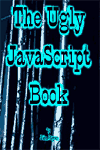
If you want to learn to speak in Geek-Squeak, that is, the language of "objects", "properties", "methods" and similar C++ programming talk, you've got the wrong book.
On the other hand, if you just want to be able to do some stuff with JavaScript, this little book may help you implement the things that you want to happen at your web site.
You probably have very little time and darned little patience with documentation, if you're like me.
So there won't be any "tests" and other stuff at the end of chapters to mess with your head.
My notion about scripting is simple: I don't care a whit about the beauty of the underlying foundations. Nor how smart the folks were who crafted the language. I just want a script to do something.
How it does it is for others to marvel at. If I can make it send today's date and time to screen, for example, I'm plumb tickled.
That it uses milliseconds since the first instant of the first month of the year 1970 doesn't seem to make an iota of difference to me, to the script, or the visitor to my pages.
So this tutorial will concentrate on teaching you to do things. Fancy names ain't gonna help that process. Some concrete examples, on the other hand, might.
JavaScript ain't as hard as folks who can do it would have you believe.
A cookbook for JavaScript may be a better way of looking at this particular text. My assumption is that you don't have much time (or inclination) to get into the esoterics.
If you had wanted to go to school to learn it, you wouldn't be looking at this book anyhow -- you'd be in a class somewhere.
And if you had wanted a really great textbook for JavaScript, you would have bought an expensive 30 or 40 buck tome from one of the big publishers instead of downloading this "online freebie"!
Of even more day-to-day use to you as you engage in your web design duties are the multiplicity of automatic scripting engines available at AutoScripter(tm), where you will find engines that write custom JavaScripts, Dynamic HTML, Cascading Style Sheets, Perl and a multiplicity of other scripts to your specific order -- all at no charge.

Using This Book is fairly simple. After you have cruised through the first couple chapters, you will have covered the elemental basics you need for scripting.
Once you have those under your belt, you don't need to continue reading chapters in any particular order.
For example, if you want to cobble together a clock or calendar, go ahead and jump to that chapter. Or if you want to mess with some sound files, skip to that chapter.
As much as possible, each chapter should stand on its own, not relying upon prior chapters' materials. Or at least that was the general idea. (I'm old and my mind wanders sometimes, you see)
When you see a script (shown in blue) on a page in this book that you want to paste into your HTML, or just want to see in action, click on the link on that page.
That action will open a new window over this screen that'll provide your demonstration.
When you've found a routine you want to use in your own script, you won't have to type it. Simply scroll down that examples page to find an Ugly JavaScript Copy-N-Paste Window with the routine you want handy for copying and pasting right into your own HTML.
JavaScript is constantly evolving as the folks at Netscape® keep improving and and adding new features to this client-side processing language.
So there may be new features of JavaScript not included in this text. You can keep up with those at Netscape's® web site.

JavaScript and LiveScript are the same. JavaScript used to be called "Live Script". It was developed by the folks at Netscape®.
At the time this book was written, only Netscape Navigator® 2.x and 3.x series browsers really supported JavaScript.
However, as of mid-1999, the Microsoft Internet Explorer® versions 4.x and 5.x also support JavaScript. Of course, Netscape® continues to lead the way with JavaScript support and new features.
It is apparent that Microsoft's® programmers are working very hard to catch up -- not just to Netscape®, but to the folks in their own marketing and hype departments.
In late 2000, the tables have been turned. America Online® and Netscape® have fallen well behind Microsoft® Internet Explorer -- not just in usage percentages, but in browser capability. Many features available in the Explorer simply aren't there in the Navigator®.
Indeed, as it stands now, you are better served to program to the Microsoft® browser.
Late Note: Netscape Navigator/Communicator® 6.2 does support nearly all the newer (Javascript 1.5) calls. 
|
